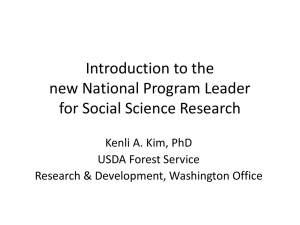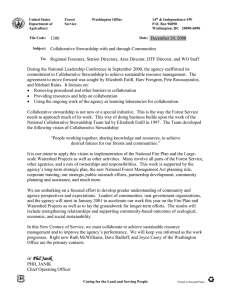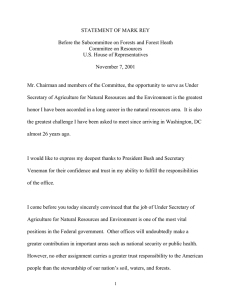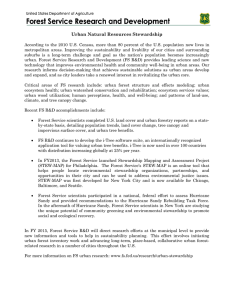Statement of before the Subcommittee on Forests and Public Land Management
advertisement
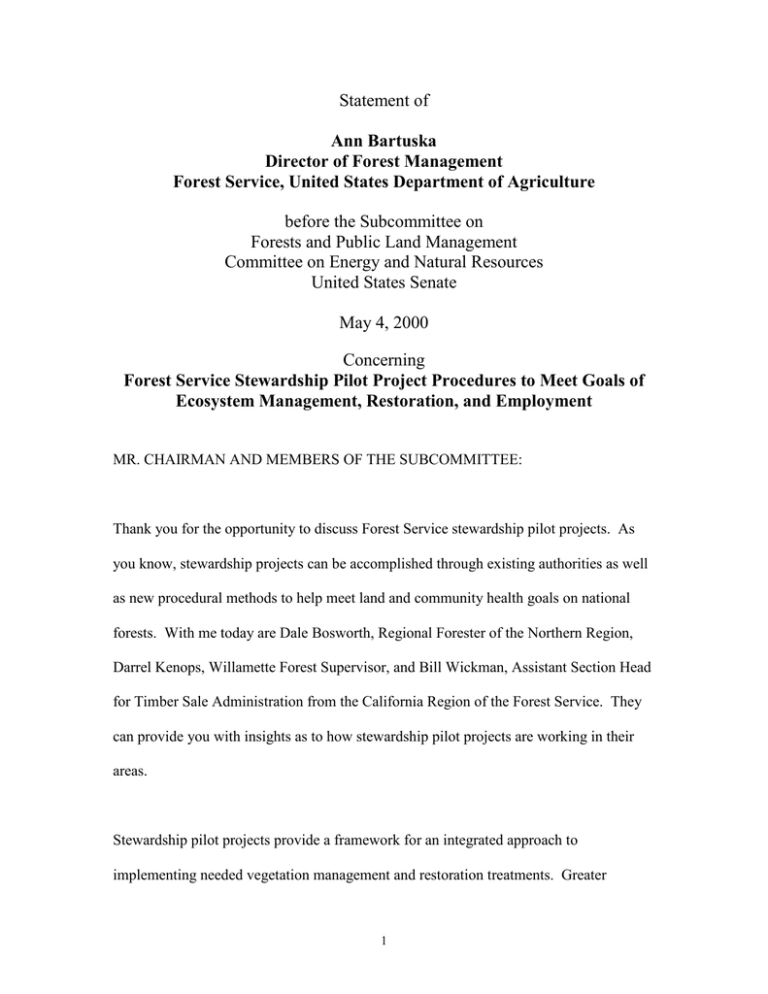
Statement of Ann Bartuska Director of Forest Management Forest Service, United States Department of Agriculture before the Subcommittee on Forests and Public Land Management Committee on Energy and Natural Resources United States Senate May 4, 2000 Concerning Forest Service Stewardship Pilot Project Procedures to Meet Goals of Ecosystem Management, Restoration, and Employment MR. CHAIRMAN AND MEMBERS OF THE SUBCOMMITTEE: Thank you for the opportunity to discuss Forest Service stewardship pilot projects. As you know, stewardship projects can be accomplished through existing authorities as well as new procedural methods to help meet land and community health goals on national forests. With me today are Dale Bosworth, Regional Forester of the Northern Region, Darrel Kenops, Willamette Forest Supervisor, and Bill Wickman, Assistant Section Head for Timber Sale Administration from the California Region of the Forest Service. They can provide you with insights as to how stewardship pilot projects are working in their areas. Stewardship pilot projects provide a framework for an integrated approach to implementing needed vegetation management and restoration treatments. Greater 1 emphasis is placed on meeting the total treatment needs of a given watershed in a unified and comprehensive manner rather than on a “sale” or “project” basis. Our experiences to date suggest that the approaches we are testing in our pilot projects may offer a number of advantages over traditional processes and procedures. New coalitions are emerging around each of the pilot projects, and often these coalitions include groups that have often felt excluded from Forest Service planning and management. One consequence of the pilot projects is that it forces seemingly disparate interests to come together and define a shared vision for the condition of the land. Developing shared goals for land health is becoming increasingly important as the Forest Service shifts its forest management practices from the primary objective of harvesting saw logs to using harvest as a tool to accomplish stewardship objectives. Unfortunately, the Forest Service’s traditional tools for managing vegetation, the standard timber sale or service contract, are frequently not well suited to efficiently meeting today's treatment needs. Bundling several watershed restoration activities into a single contract may offer a number of potential advantages, such as, reduced contract preparation and administration costs; reduced treatment costs because fewer equipment moves and set-ups are required; and more stable, year-round employment for contractors. The standard timber sale contract was not designed to accomplish land health objectives and is not well suited to efficiently meet a wide range of other stewardship needs. The timber sale contract limits the types of activities that a contractor can be required to perform as a condition of the contract. These activities must be directly related to removal of the timber being sold, such as, road maintenance and construction, snag 2 falling, and brush disposal. This restriction limits the Agency's ability to accomplish multiple objectives through timber harvest, such as road obliteration, stream restoration, noxious weed control, and installation of wildlife habitat improvement structures. The service contract provides a very flexible and powerful tool, but in the absence of up front funding to pay for needed treatments, its utility is limited. In fact, it could be argued that with adequate appropriations, use of the service contract could accomplish almost everything we can accomplish through stewardship pilots. The agency has not widely tested the use of service contracts in which commercially valuable materials were part of the service contract. The Forest Service has been working to find ways to utilize our timber sale and service contracting authorities more effectively and provide flexibility at the local level. We implemented several stewardship projects in 1997 and 1998 within these authorities. Additionally, we have developed a hybrid contract combining elements of both timber sale and service contracts. The USDA Office of General Counsel is presently reviewing this contract. We hope to have it available for the field to use soon. [SHOW BEFORE AND AFTER GRAPHIC OF ASPEN TREATMENT.] As members of the subcommittee and the public are aware, significant vegetative treatment needs exist on the national forests. We estimate that resource values on some 24 million acres of national forest lands are at a high risk of loss due to insects and 3 disease. Just within the interior west, our estimate is that 24 million acres of national forest land are at high risk of loss due to wildfire. On many of these acres, high stand densities, principally by small-sized trees that are presently of limited commercial value, are a major contributor to heightened risk. Often, these stands require thinning before other management tools, such as prescribed burning, can be applied. Even the use of prescribed fire as a vegetation management tool may diminish as air quality standards are tightened. In 1998, Congress passed the Fiscal Year 1999 Omnibus Appropriations Act. Section 347 of this Act authorizes the Forest Service to enter into up to 28 stewardship endresults demonstration pilot projects. It sets forth various new processes and procedures that the Forest Service can test in connection with these pilot projects. These new processes and procedures include the following: • The exchange of goods for services; • The retention of receipts; • The awarding of contracts on a “best value” basis; and • The designation of timber for cutting by prescription. [SHOW U.S. MAP OF PROJECTS GRAPHIC] We have identified 28 stewardship pilot projects authorized by Section 347. We also are continuing to implement those projects being carried-out using existing authorities. The 4 pilots are widely distributed geographically. Thirty two national forests in fifteen states have projects. The objectives of the pilot projects are diverse and fall into two broad categories, ecological and socio-economic. Ecological objectives cited in connection with at least ten of the pilots include the following: • Reducing the risk of catastrophic wildfire and/or creating conditions conducive to allowing fire to play a more natural role in maintaining desired ecosystem conditions; • Improving habitat for various species of wildlife such as grizzly bear, elk, bighorn sheep, and neo-tropical birds; • Protecting water quality and fish habitat by reconstructing or decommissioning roads and by stabilizing mine sites; and • Restoring ecosystem patterns and functions to their natural range of variability and enhancing vegetative biodiversity. Other ecological objectives cited in connection with multiple projects include the following: • Improving the overall health and vigor of forest stands; • Improving riparian areas; • Controlling noxious weeds; 5 • Addressing existing insect and/or disease problems; • Improving recreation values; and • Rehabilitating visual values on old clearcut areas. Socio-economic objectives listed include: • Providing wood products to help support local economies; • Exploring ways to improve efficiency and reduce treatment costs; • Evaluating the potential usefulness of logging services contracts; and • Encouraging the development of markets for small diameter and under-utilized material. These projects, in total, test all the new administrative processes and procedures approved by Congress, as well as demonstrate the flexibility in our existing authorities. Nearly half these projects have completed NEPA and are ready to proceed toward full implementation. However, very few of them have actually progressed to the point that contracts have been awarded and actual on-the-ground work has begun. A diverse array of cooperators, including commodity and non-commodity interests, federal and state agencies, academia, and tribal governments, are presently involved in our projects. 6 While there are many positive aspects of the pilot projects, some problems are being encountered, such as how best to report accomplishments for multi-funded projects, and how to ensure adequate up-front funding when contract logging will be utilized. The cost of implementing projects is a continuing concern as we look at treatment options over larger areas with lower value wood products. Stewardship projects should not be allowed to become solely an exercise in encouraging and promoting commodity-purpose timber sales to pay for restoration costs on other parts of the forest. If that is allowed to occur, we predict that stewardship projects may suffer the same fate as our regular timber sale program--widespread criticism and lack of public trust. Stewardship projects cannot replace the need to make up front investments in land health--investments that will provide jobs, revenues, and healthier forests for years to come. Lastly, recognizing that one of the fundamental goals of the stewardship approach is to support local communities, there is a need to determine what constitutes “local.” The authority to award contracts on a “best value” basis may provide the Forest Service with greater flexibility to target work towards local businesses. This flexibility, however, needs to be balanced with the need to allow enough open competition to improve efficiency and reduce costs. 7 Summary We feel that stewardship pilots are a very important experiment in alternative contracting arrangements. Stewardship projects have the potential to lead to new arrangements and approaches that could prove critical to addressing both current and future vegetation management needs on the national forests. This concludes my testimony. My fellow panelists and I are willing to answer any questions that you may have. 8
